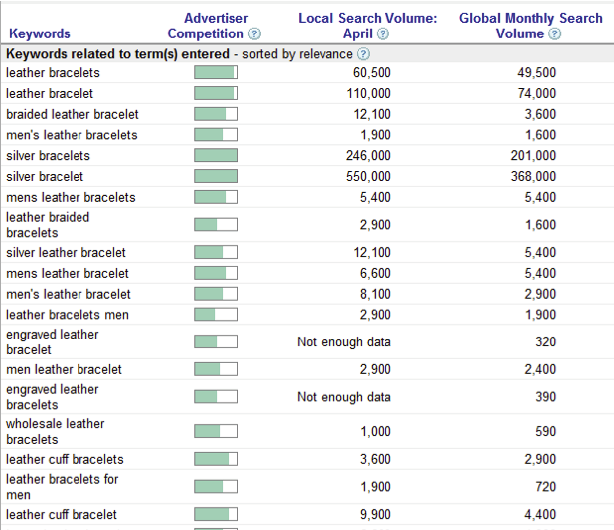Develop a Smart Keyphrase Strategy to Optimize Conversions
 As promised, today we’re going to delve into the nitty-gritty of generating keyphrases to optimize content that targets all phases of our prospects’ buying cycle: awareness, research, and purchase. To capture our prospects “clicks” in each phase of the buying cycle, we’ll want to devise a keyphrase strategy that places our brand front and center, throughout. So without further ado, let’s get into how to develop an effective keyphrase strategy for conversions optimization!
As promised, today we’re going to delve into the nitty-gritty of generating keyphrases to optimize content that targets all phases of our prospects’ buying cycle: awareness, research, and purchase. To capture our prospects “clicks” in each phase of the buying cycle, we’ll want to devise a keyphrase strategy that places our brand front and center, throughout. So without further ado, let’s get into how to develop an effective keyphrase strategy for conversions optimization!
Building your core keyphrase “seed” list
Every SEO copywriting and content marketing campaign works with a core (“seed”) list of researched keyphrases that reflects the entire buying cycle,”and yes, that can translate into one monster of a list! If you have a ten-page site, your seed keyphrase list will most likely contain fewer then 100 keyphrases. At the other end of the spectrum, if you’ve a large e-commerce site, you’re probably looking at thousands of keyphrases across product categories, brands, and sub-categories.
Regardless of the relative depth and complexity of your site, the same SEO strategy/conversions goal applies: Get found, then convert!
Let’s begin at the beginning. Your first task, while seemingly daunting, is actually very simple: brainstorm your keyphrases. Put yourself in the customers’ shoes and try to figure out the terms they would most likely use to find you. Don’t forget keyphrases that reflect customer preferences, such as:
- Your location (essential if you want local traffic)
- Product brand names
- Product makes/models
- Individual/Unique (U.S.P.)
If you’re working on a large site with multiple sections, and feeling overwhelmed, simply choose one section of your site and do SEO research just for that: “Eat the elephant, one bite at a time!” (The same advice applies to smaller sites.) The ultimate goal is to conduct keyphrase research across all site sectors/buying cycle phases, incorporating your brand terms, products/services, and general, overarching keyphrases.
Brainstorming brilliant keyphrases
Let’s start with this example: Your client is in the business of selling bracelets both locally and nationally, through their website. And let’s assume that you want to focus your efforts on “leather bracelets” versus other possibilities for that section of their e-commerce site.
Some possible “seed” keyphrases to begin your research could be:
- Leather bracelet
- Leather bracelets
- Braided leather bracelet
- Women’s leather bracelet
- Men’s leather bracelet
- Women’s jewelry
- Men’s jewelry
- Silver bracelets (for contrasting results/negative research)
Now, let’s do some keyword research using Google’s free tool. Here are the initial results for the search term “leather bracelet”:
In considering the yearly-averaged, approximate search volume, understand that even poorly trafficked terms can be important to your campaign, depending upon what you’re selling. This is especially true of B2B marketing: there may be only three searches/month for a particular piece of industry-specific equipment, but capturing just one of these web surfers could result in a huge, six- figure sale!
For your content message, you’ll want to look hard at the “approximate/local search volume” results of keyphrase research. People tend to search more for different products/services at different times and seasons of the year. Referring to our “bracelets” example, it’s clear that searches for “silver leather bracelet” spiked in April. It follows that you’d want to generate a lot of solid content around “silver leather bracelet” for a spring SEO campaign focus.
So try this: run your most general keyphrases through Google’s keyword tool, and see what happens. Now, you have your SEO “seed” list. Then run those keyphrases from your seed list though the keyword research tool, and see what happens…A more refined list! That’s how you can “drill down” and distill the most effective, high-octane keyphrases, from the most general over-arching terms down to the most specific, to use throughout your content to capture your prospects’ clicks!
Stay tuned, as next week we will discuss the process of “keyphrase filtering”!


Well I found this article very informative and full of knowledge. Well thanks for sharing your experience. I will also try this.
Amazing article i loved it and following for the next part… This explanation with examples really helps…. Thank you!
I appreciated how this article was structured – very methodical. Your review of “What do these initial results mean?” was very helpful in determining which search results are most relevant for keyword research. Well done!
Thanks so much, @Angie! Glad that you enjoyed it! :)